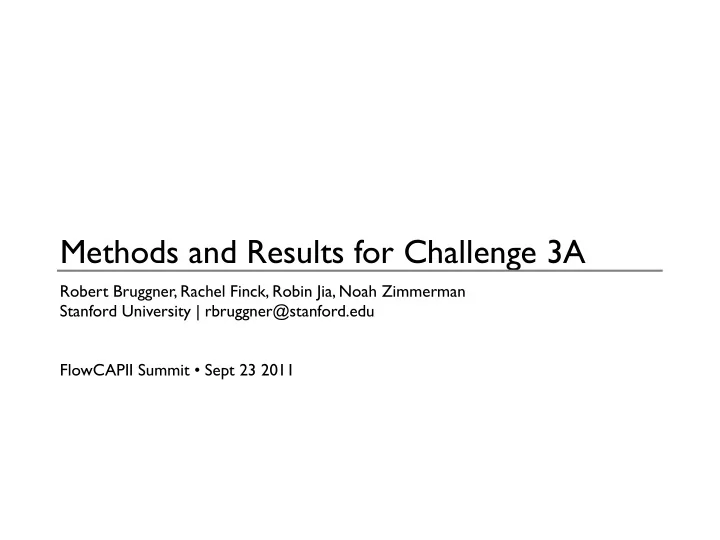

Methods and Results for Challenge 3A Robert Bruggner, Rachel Finck, Robin Jia, Noah Zimmerman Stanford University | rbruggner@stanford.edu FlowCAPII Summit • Sept 23 2011
Challenge 3A and Method Overview
Challenge 3A and Method Overview • Given two tubes of data from a single patient, predict the antigen used in each tube
Challenge 3A and Method Overview • Given two tubes of data from a single patient, predict the antigen used in each tube • Our Approach: Automatically identify populations of cells by surface marker - Extract population meta-features and build model to predict antigen group -
Challenge 3A and Method Overview • Given two tubes of data from a single patient, predict the antigen used in each tube • Our Approach: Automatically identify populations of cells by surface marker - Extract population meta-features and build model to predict antigen group - • Identified a highly predictive population for determining antigen group
Surface Markers Normalized for Simple Cluster Matching
Surface Markers Normalized for Simple Cluster Matching • Surface marker expression variable between patients
Surface Markers Normalized for Simple Cluster Matching • Surface marker expression variable between patients • Need to establish population correspondence
Surface Markers Normalized for Simple Cluster Matching • Surface marker expression variable between patients • Need to establish population correspondence • Assume bimodal expression & landmark normalize
Cells Clustered With 2D Density-Based Merging & Greedy Dimensional Exploration
Cells Clustered With 2D Density-Based Merging & Greedy Dimensional Exploration • Data from all patients and conditions combined
Cells Clustered With 2D Density-Based Merging & Greedy Dimensional Exploration • Data from all patients and conditions combined • Combined data clustered in all pairwise sets of dimensions
Cells Clustered With 2D Density-Based Merging & Greedy Dimensional Exploration • Data from all patients and conditions combined • Combined data clustered in all pairwise sets of dimensions • Dimensions with highest confidence clusters selected
Cells Clustered With 2D Density-Based Merging & Greedy Dimensional Exploration • Data from all patients and conditions combined • Combined data clustered in all pairwise sets of dimensions • Dimensions with highest confidence clusters selected • Identified clusters recursively projected and clustered until no new clusters found
Per-patient Cluster Meta-features Extracted For Model Construction
Per-patient Cluster Meta-features Extracted For Model Construction • Data separated back into source components
Per-patient Cluster Meta-features Extracted For Model Construction • Data separated back into source components • Cluster Meta-features extracted Cluster density - Antigen condition density difference - vs negative controls Response of clusters in cytokine - response dimensions as quantified by Earth Mover's Distance (EMD)
Per-patient Cluster Meta-features Extracted For Model Construction • Data separated back into source components • Cluster Meta-features extracted Cluster density - Antigen condition density difference - vs negative controls Response of clusters in cytokine - response dimensions as quantified by Earth Mover's Distance (EMD) • Logistic Regression Classification Model built from features GLMNET
Cross validation Used to Identify Optimal Classifier and Features
Cross validation Used to Identify Optimal Classifier and Features • 100 runs of random 3-fold internal cross validation using different combinations of features
Cross validation Used to Identify Optimal Classifier and Features • 100 runs of random 3-fold internal cross validation using different combinations of features • Logistic regression model using cluster difference and EMD features had best performance
Cross validation Used to Identify Optimal Classifier and Features • 100 runs of random 3-fold internal cross validation using different combinations of features • Logistic regression model using cluster difference and EMD features had best performance • Used to predict test labels
Density of CD4/CD8 Double Positive T -cell Population Most Important Factor in Logistic Regression Model
Density of CD4/CD8 Double Positive T -cell Population Most Important Factor in Logistic Regression Model GAG# GAG# ENV# ENV# 0.42%# 0.42%# 0.21%# 0.21%# 0.18%# 0.18%# 0.27%# 0.27%#
Density of CD4/CD8 Double Positive T -cell Population Most Important Factor in Logistic Regression Model • Backgating suggest possibly two subpopulations within CD4/CD8 cells
Thoughts & Future Work
Thoughts & Future Work • Identification of CD4+/CD8+ population highlights unbiased nature of method
Thoughts & Future Work • Identification of CD4+/CD8+ population highlights unbiased nature of method • Need to identify all potentially predictive features and their predictive power for users
Thoughts & Future Work • Identification of CD4+/CD8+ population highlights unbiased nature of method • Need to identify all potentially predictive features and their predictive power for users • Automated methods critical for comprehensive exploration of higher-dimensional data
Thanks & Questions
Thanks & Questions • J. Irish, D. Parks, R. Tibshirani, D. Dill, & G. Nolan
Thanks & Questions • J. Irish, D. Parks, R. Tibshirani, D. Dill, & G. Nolan • FlowCAPII Committee
Thanks & Questions • J. Irish, D. Parks, R. Tibshirani, D. Dill, & G. Nolan • FlowCAPII Committee • NIAID
Thanks & Questions • J. Irish, D. Parks, R. Tibshirani, D. Dill, & G. Nolan • FlowCAPII Committee • NIAID • Questions? rbruggner@stanford.edu
Recommend
More recommend